Judging from the house price-to-household income ratio and the rent-to-house price ratio, house prices seem to have reached bubble levels in major cities in China. However, following a shift in the authorities' monetary policy stance from easing to tightening in mid-2013, the climb in house prices has given way now to a correction phase. If the housing bubble bursts, it will impact not only related industries but also the overall macro economy.
House prices reaching bubble levels
House prices in China are largely affected by economic trends and, ultimately, the authorities' stance on monetary policy. Following the monetary easing after the collapse of Lehman Brothers, prices rose sharply in major cities such as Beijing and Shanghai. To address this problem, the Chinese government announced and implemented a series of steps after 2010, including restrictions on lending and purchases of housing and a tightening of the real estate-related tax system as measures to reduce demand, while accelerating the construction of low-cost housing as a measure to increase supply. With these measures proving effective, the year-on-year rate of increase in sales prices of newly constructed commercial residential buildings in 70 large and medium-sized Chinese cities turned negative at one point, but it turned positive once again in January 2013 on the back of subsequent monetary easing and accelerated to a peak of 9.7% in December 2013 (Figure 1).
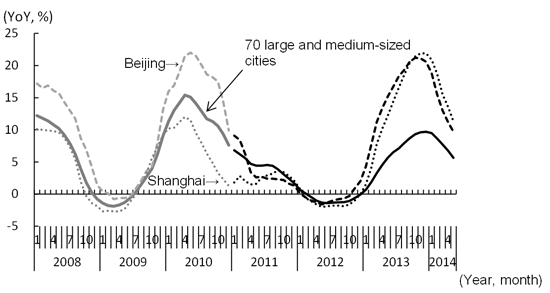
Judging from the house price-to-household income ratio and the rent-to-house price ratio, it is fair to say that house prices already have deviated markedly from the equilibrium level and reached the level of a bubble. First, in 2013, the house price-to-household income ratio (household income is measured on an annual basis) was high in major cities, reaching 19.1 in Beijing and 18.1 in Shanghai (Figure 2). These figures are higher than the equivalent in Tokyo during the bubble period of the late 1980s. Meanwhile, the rent-to-house price ratio (rent is measured on an annual basis) in 2013 in major cities, including Beijing (at 2.0%) and Shanghai (at 2.4%), were much lower than the deposit rate (the basic rate on one-year deposits is 3.0%, and the regulated cap rate is 3.3%) (Table 1). For investors, in the absence of capital gain from rising house prices, the rate of return based on rent income alone would be extremely low.
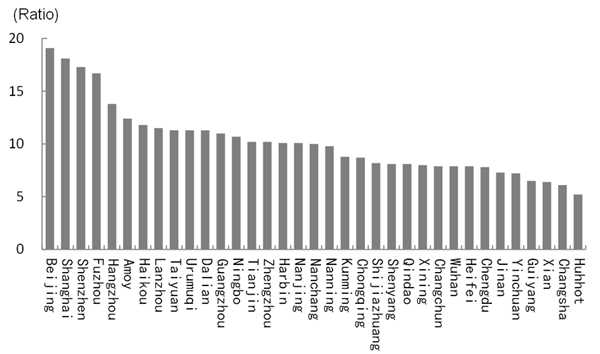
| (a) Rent (Annualized, Yuan/m2) | (b) House price ( Yuan/m2) | Rent-to-house price ratio ((a)/(b), %) | |
|---|---|---|---|
| Beijing | 761.0 | 37,865 | 2.0 |
| Shanghai | 702.5 | 29,622 | 2.4 |
| Shenzhen | 631.2 | 26,494 | 2.4 |
| Amoy | 435.5 | 21,869 | 2.0 |
| Sanya | 489.4 | 19,334 | 2.5 |
| Wenzhou | 407.0 | 19,180 | 2.1 |
| Guangzhou | 494.3 | 18,400 | 2.7 |
| Hangzhou | 479.2 | 18,229 | 2.6 |
| Nanjing | 405.2 | 18,049 | 2.2 |
| Tianjin | 381.5 | 15,977 | 2.4 |
| Source: Compiled by the author based on CityRE data (http://data.cityhouse.cn/). | |||
Housing market entering a correction phase
Since the beginning of 2014, house prices have entered a correction phase. In May, the year-on-year rate of increase in sales prices of newly constructed commercial residential buildings in 70 large and medium-sized Chinese cities slowed to 5.6%. On a month-on-month basis, too, the number of cities where house prices are rising has been decreasing rapidly, while those that are falling or remaining flat have been increasing (Figure 3).
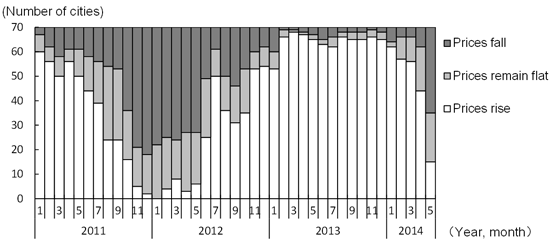
The shift in the authorities' stance on monetary policy, from easing to tightening once again, is believed to have caused house prices to enter the correction phase. In fact, growth in the supply of funds to real estate developers has been slowing since 2013 in line with slower growth in total social financing (TSF) (both are on a year-on-year basis) (Figure 4). In addition, a rise in interest rates associated with the liberalization of interest rates and the tightening of credit to the shadow banking sector by the authorities also have led to funding costs. In response, housing demand has been declining, while some real estate developers who have run short of funds have been accelerating the disposition of stock by cutting prices.
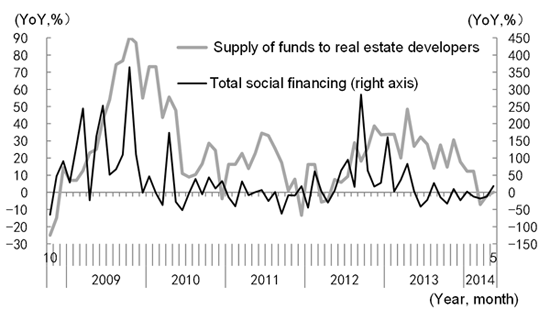
To provide insights into future house prices, attention should be paid to movements in the floor space sold of residential buildings, which serves as a leading indicator (Figure 5). After the collapse of Lehman Brothers, while the growth rate (year on year) of the floor space sold of residential buildings peaked in November 2009 and bottomed out in January/February 2012, before rising to a peak in January/February 2013 once again, the growth rate (year on year) of sales prices of residential buildings hit the turning point six to 12 months later. Inferring from the fact that growth in the floor space sold of residential buildings has been negative since the beginning of the year, it looks likely that growth in the sales prices of residential buildings will slow further and turn negative in the future.
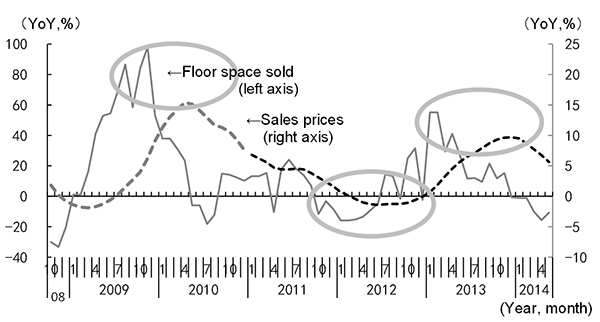
Expected impact of falling house prices
As real estate is an important industry that has been driving the Chinese economy, falling house prices are expected to have a significant impact not only on the real economy, but also on the monetary and fiscal aspects of the Chinese economy (Table 2).
| Amount (billion yuan) | Ratio to GDP (%) | |
|---|---|---|
| Real estate development investment | 8,601.3 | 15.1 |
| Housing | 5,895.1 | 10.4 |
| Sales amount of real estate | 8,142.9 | 14.3 |
| Housing | 6,769.5 | 11.9 |
| Transfer of land | 4,125.0 | 7.3 |
| Tax revenues related to real estate | Approx. 2,000.0 | Approx. 3.5 |
| Real estate loans of financial institutions | 14,610.0 | 25.7 |
| Housing loans to individuals | 9,800.0 | 17.2 |
| Reference | ||
| GDP | 56,884.5 | - |
| Total fiscal revenue in China (including revenues of government-controlled funds) | 18,138.2 | 31.9 |
| Total loans of financial institutions | 71,900.0 | 126.4 |
| Source: Compiled by the author based on the data from the National Bureau of Statistics of China, the Ministry of Finance, and the People's Bank of China | ||
First, in terms of the real economy, real estate development investment in 2013 stood at 8.6 trillion yuan, equivalent to 15.1% of the gross domestic product (GDP). If the real estate market weakens, real estate development investment will not grow as strongly as it did in the past. This will not only lower GDP growth directly, but also put a damper on the economy through declining demand in related industries such as steel, consumer electronics, and furniture.
Real estate-related loans of financial institutions at the end of 2013 reached 14.6 trillion yuan (20.3% of the total loan of 71.9 trillion yen). Including loans via shadow banking products such as wealth management products and trust products, the size of funds flowing into the real estate market would be even larger. There has been growing concern that if house prices fall, an enormous volume of non-performing loans will arise from bank loans to the real estate industry. However, as a result of restrictions imposed on housing loans in recent years, such as the hike in the down payment ratio, this concern looks unwarranted, and, although defaults on shadow banking products may increase from now on, the direct impact on banks is expected to be limited.
In addition, revenues from the transfer of land for local governments amounted to 4.1 trillion yuan in 2013. When real estate-related tax revenues amounting to approximately two trillion yuan are also taken into consideration, it is estimated that about one-third of fiscal revenues in China rely on land. If real estate prices collapse, government revenues could drop sharply. As a result, public spending, particularly on infrastructure, will be reduced.
There are fears that if the housing bubble bursts, China will follow the same fate as Japan, which suffered the "two lost decades" from the 1990s. However, unlike Japan, which was already a mature, advanced economy at the time when the bubble burst, China, which is still a developing county, should be able to achieve economic growth of 6%-7% if it makes use of its latecomer advantage. The expected advance of urbanization in particular will be a driving force to support real estate investment as well as economic growth. As such, although an economic slowdown will be unavoidable in the short term if the housing bubble bursts, the Chinese economy should be able to avoid a long-term slump.
The original text in Japanese was posted on June 4, 2014. Data have been updated to reflect the latest information.


